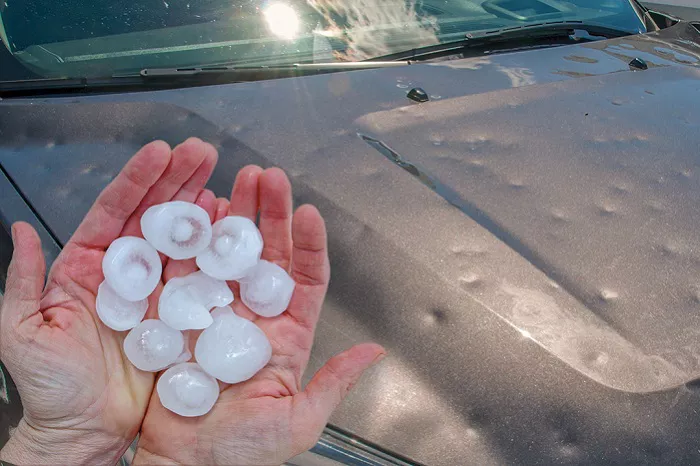Hail damage to cars is a common problem after severe storms. Hailstones can vary in size from small pea-sized pellets to large chunks as big as baseballs, falling at high speeds. When these ice balls hit your car, they can cause many dents, dings, and even break windows or mirrors. This damage not only affects the look of your car but can also lower its value and cause long-term issues if left untreated.
This article will guide you through understanding hail damage, spotting it, and detailed step-by-step methods to fix your car, both at home and with professional help. Whether you want to save money or just learn about car care, this guide will help you restore your vehicle’s appearance and value.
What is Hail Damage?
Hail damage occurs when hailstones strike your vehicle’s surface, causing dents and sometimes paint damage or broken glass. The severity depends on hail size, speed, and exposure time. Common signs of hail damage include:
Small to large dents on the hood, roof, doors, and trunk
Cracked, chipped, or broken windows and mirrors
Stuck or jammed doors and side mirrors due to damage
Water leaks inside the car if glass is broken
The damage may look minor, but it can reduce your car’s value and lead to further problems if not fixed.
Step 1: Assessing the Damage
The first thing you should do is inspect your car thoroughly. Look at the roof, hood, trunk, doors, and all windows. If your car has a metallic finish, small dents will be easier to spot under sunlight.
Tips for inspecting hail damage:
- Wash the car before inspection. Dirt can hide small dents.
- Look at the car from different angles.
- Use a flashlight or your phone’s light in dim areas.
- Take photos of all the damage.
Write down everything you see. This list will be helpful if you plan to file an insurance claim.
Step 2: Contact Your Insurance Company
If your car insurance policy includes comprehensive coverage, hail damage is usually covered. Call your insurance company as soon as possible after the storm.
Here’s what you’ll need:
- Policy number
- Date and time of the hailstorm
- Photos of the damage
- Your inspection notes
An insurance adjuster will come to inspect your car. After that, you’ll receive an estimate for the cost of repairs. If you agree with the estimate, the repair process can begin.
See Also: The 8 Best Trucks in the Snow 2025
Step 3: Choose the Right Repair Method
There are several ways to fix hail damage. The right method depends on how severe the damage is.
Paintless Dent Repair (PDR)
This is the most popular method for fixing small to medium-sized dents. It’s fast, affordable, and doesn’t harm the original paint.
How it works: A technician uses special tools to massage the dent from behind the panel.
Pros: Maintains factory paint, faster repairs, lower cost.
Cons: Doesn’t work for large dents or paint-damaged areas.
Traditional Bodywork
If the paint is cracked or the dent is too deep, traditional repair methods may be needed.
How it works: The area is sanded, filled with body filler, and then repainted.
Pros: Best for major damage.
Cons: More expensive, takes longer, and may not match factory paint exactly.
DIY Dent Repair Kits
You can buy kits online or at auto parts stores. They include tools like suction cups, glue guns, and pullers.
Pros: Low cost, good for minor dents.
Cons: Risk of making the damage worse, no paint correction.
If you’re not experienced with car repairs, it’s best to leave this to the professionals.
Step 4: Find a Reputable Repair Shop
Choose a shop that specializes in hail damage repair. Look for the following:
- Certified technicians
- Good online reviews
- Warranty on repairs
- Experience with insurance claims
Ask for a detailed written estimate before any work begins. A good shop will also explain the repair methods they plan to use.
Step 5: Prevent Future Hail Damage
While you can’t stop a hailstorm, you can take steps to protect your car:
- Park in a garage or covered area.
- Use a car cover made for hail protection.
- Monitor weather forecasts, especially during storm season.
- Use a mobile app to get storm alerts.
These steps can help you avoid costly repairs in the future.
See Also: The Baker Electric Car: A Forgotten Pioneer in EV History
Frequently Asked Questions
1. How much does hail damage repair cost?
Small dents: $30–$50 per dent using PDR.
Moderate damage: $1,000–$2,000 for multiple dents.
Severe damage: $5,000 or more, especially if glass or panels need replacing.
2. Will my insurance rates go up?
Comprehensive claims usually don’t raise your premiums, but this depends on your insurance provider and your claim history.
3. How long does the repair take?
PDR: 1 to 3 days
Bodywork: 3 to 10 days
Severe cases may take longer if parts need to be ordered.
4. Is it safe to drive a car with hail damage?
If the damage is only cosmetic, the car is usually safe to drive. But cracked glass or sharp edges from broken parts can be dangerous.
Final Thoughts
Fixing hail damage is important to maintain your car’s appearance and value. While minor dents might not seem serious, they can lead to rust or lower resale prices. Always inspect your vehicle after a storm and take action quickly.
Use paintless dent repair for small dents, and seek professional help for deeper or more serious damage. Your insurance company can help cover the costs if you have the right policy.

